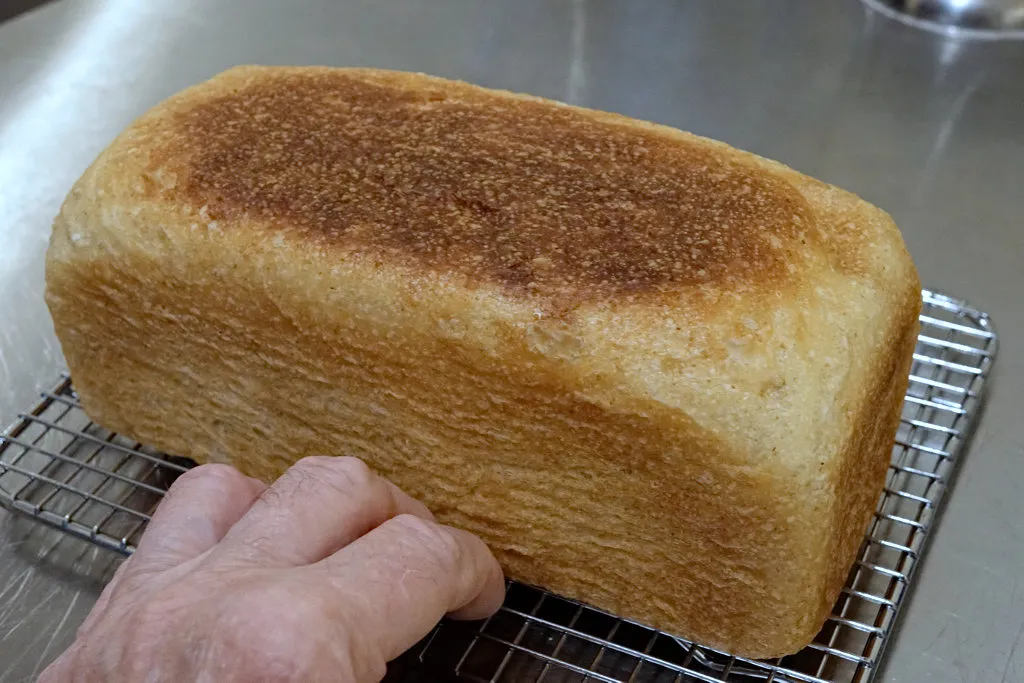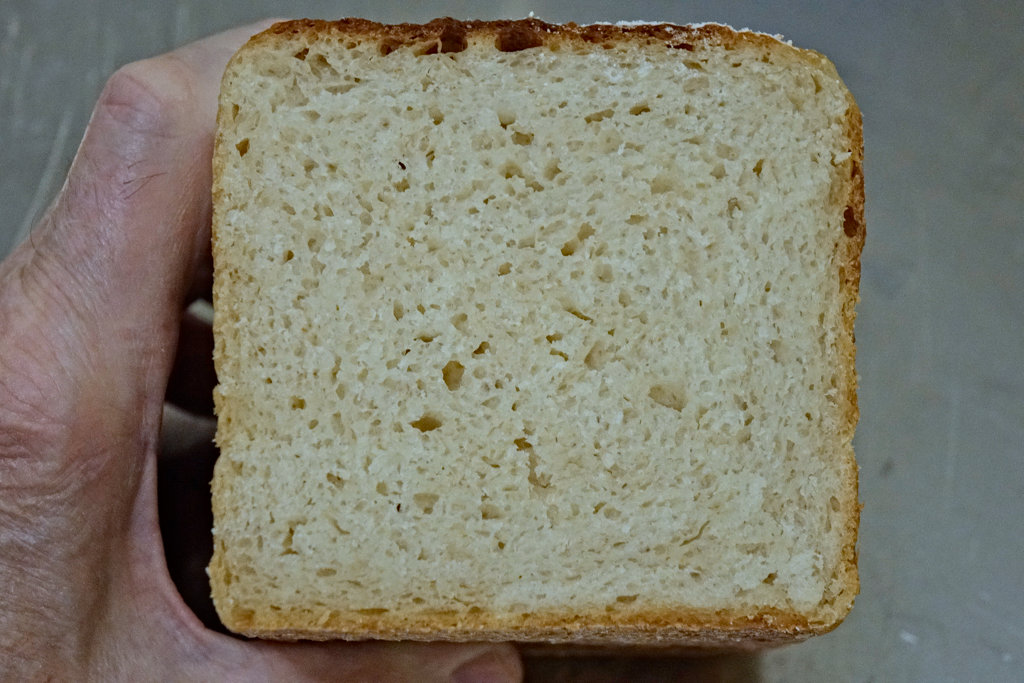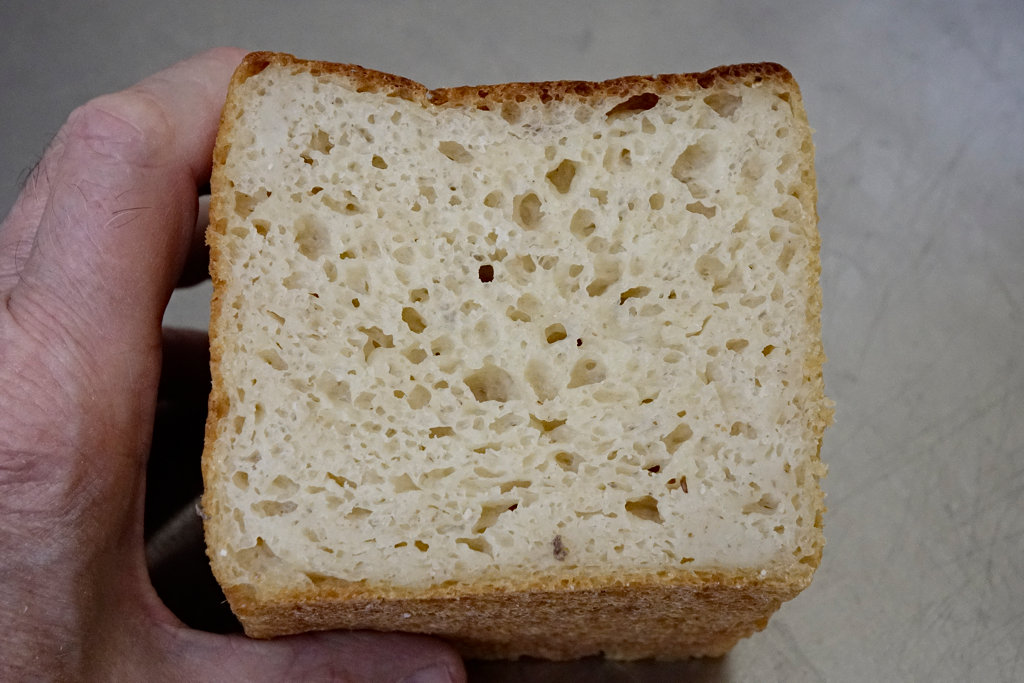
Continuing with the twin themes of Cream Of Wheat and Pullman loaves, here is a yeasted Pullman loaf made with a yudane that used Cream Of Wheat for the flour. I included the COW in the total flour weight for baker's percentage calculations.
Recipe
---------
- 450g - flour
- 90g - (20%) - Cream of Wheat (Yudane)
- 360g - AP
- 180g - total added liquid (90g water, 90g milk)
- 315g - target liquid (70%)
-180 - water in yudane (twice the weight of the COW)
+45g - yudane makeup water (only ~75% of yudane liquid seems to contribute to the hydration)
- Trinity
- 30g - eevo
- 30g - honey
- 30g yogurt
- 1 tsp - SAF dried yeast
- 8 g - salt
Process
---------
- make yudane: dump boiling water into COW, stir. Cool
- warm milk to room temp, mix with water
- combine flour, salt, yeast
- Add liquid, stir
- Add yudane, mix by hand, break up lumps
- add Trinity, mix: wet, sticky dough
- rest 30m, knead/stretch: dough weak
- rest 45m, S&F: weak but gaining strength, less sticky
- rest 25m, S&F: slightly risen, better strength, more cohesion
- rest 15m, butter pan
- shape: the "log" became an oval shape where the top was somewhat higher than the ends. The dough seemed to fill the pan less than half way
- place dough into pan
- proof 2 hrs
- bake - countertop oven 375°F, lid on 42 min + 5 minutes lid off.
The baked loaf had pressed gently against the lid except at both ends. It browned where it had touched the lid. The sides were lightly browned. So 450g total flour including the yudane, was not quite enough to fill the pan but close. Probably without a yudane there would have been enough or likely more than enough to fill the pan completely with some pressure.
Result was a soft bread with moist, medium open crumb. The taste is mild yet has a richness. It makes very good buttered toaast.
In a previous attempt I had a mind blip and used much too much liquid: 164g too much!That dough was nearly like a waffle batter. The bread filled the pan the same amount after baking. The crumb was much more open and the flavor more intense, though the slices were softer and more delicate.
Here is the crumb of this bake, and below it the crumb of the one with all that extra liquid:


- tpassin's Blog
- Log in or register to post comments
Both crumbs look wonderful. My next bake will definitely be a Pullman loaf so it’s great to get some inspiration from all of you.
Best,
Ian
Thank you, Ian, and I'm so sorry about your mother. So hard for you, I know.
🙏🏻🙏🏻
I’m confused about the water. Can you write out the amounts as they are added in the “ process” section.
I like that the CoW is “ cooked”. I wonder if the previous use of CoW led to your blockage? I worried about that when I first saw your use of it.
The crumb is lovely in both. I’ll have to try this . I might make the CoW like I would any porridge / polenta. c thank you!
I don't think the scald/yudane was related to my blockage. I've made them before (with other grains) with no problem. And yes, I'm sure that cooking the grain into porridge will work perfectly. I've done it with oatmeal and got a fine result. In fact, this COW seemed like an ordinary thick porridge even though it was scalded instead of being cooked in a pot.
Here's the scoop about the water. The main question with scalds/yudanes/tanzhongs is whether to include all the scald water as part of the hydration of the dough. At least for COW, it seems that not all the scald water adds to the effective hydration. I'm still tuning it up but for this bake I estimated that only 75% of the scald's water would go towards the hydration (going by the feel of the dough). I used 90g of COW and 180g of water. So 0.75 * 180 = 135g is liquid in the scald that will contribute to the effective planned hydration. The target weight of liquid was 315g or 70% hydration.
450g = total planned flour including the COW
-90g COW in scald
------
360g non-COW flour to use
315g = total planned liquid
-135g (water contributed by the scald)
-------
180g = liquid to add to the non-COW flour
I poured the 180g of water+milk into the 360g of flour and mixed. Then I added the scald. The dough seemed a little dry after I added the scald but it seemed a little wetter than I expected after adding the Trinity. So everything balanced out more or less.
Since the bread in the second crumb shot, the one that had the extra 164g of liquid, still worked out (amazing!), I suggest that you use more liquid than I did with this bake. It will be easier on your wrists when you mix in the porridge. Some of that extra liquid could go into the porridge. I used 50-50 milk-water for the 180g of added liquid but 100% milk would probably be a good move.
If you want to fill a 4 X 4 X 9 Pullman a little more than this loaf did, you could increase the flour up from my 450g, say by 10% (and increase everything else by the same factor). Scale everything for your longer pan, of course. If you go for much more liquid, maybe use bread flour instead of AP because the baked loaf will be more delicate otherwise.
I used a relatively small amount of yeast (1tsp) to allow for a longer bulk ferment. That gave me time to do my few S&Fs before much rising set in. Note that you can still do a S&F after you notice some rising! The extra time should have added to the flavor as well.
I guess I thought you were initially using the dried CoW and hadn’t soaked it or pre cooked it.
I’ll have to give this a try. I have lots of grits but haven’t put them in bread.
I used 300g of the Kamut in a Pullman and decided to retard it. Total weight 1460g / 600g flour 1/2 Kamut and 1/2 Stardust ( white hard wheat) it was the silkiest dough ever and rose like crazy. Will see how it bakes up tomorrow.
CoW is turning out to be quite versatile.
An interesting take on the previous bread, Tom, and interesting read even for those of us who live in parts of the world where cream of wheat isn't a thing.
Did you enjoy the flavour of this one as much as the previous 50% cream of wheat one?
-Jon
Yes, I would say I enjoyed it as much. With no refrigerated stay there was no hint of sourness - a difference, not necessarily better or worse. This Pullman version has that slightly buttery, slightly crunchy crust that buttering the pan provides.
Love the buttered toast! I made the loaf that had way too much water because visitors were coming for a few days and had expressed an interest in bread. I used yeast instead of sourdough because I was pressed for time. The loaf was a big hit. One morning they made Texas toast for breakfast. Texas toast is a very thick slice that is pan-fried both sides in butter and they raved about it.